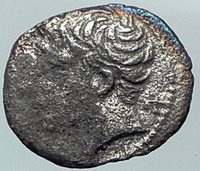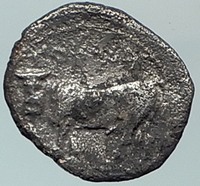|
Greek city of
Panormos
in
Sicily
As Ziz (but without Punic 'sys')
Silver Litra 11mm (0.63 grams) Struck circa 405-380 B.C.
Reference: Jenkins, Punic pl. 24, 14.
Youthful male head to left.
Bearded man-headed bull walking to left, his head turned slightly towards
the viewer.
The principal Phoenician city in Sicily, Panormos produced a limited coinage in
the latter part of the 5th Century; but following the great success of
Carthaginian arms, 409-405 B.C., the issues of the mint became much larger. The
types are mostly copied form the coinages of other Sicilian cities, such as Gela,
Segesta and Syracuse.
You are bidding on the exact
item pictured, provided with a Certificate of Authenticity and Lifetime
Guarantee of Authenticity.
Palermo is a city in
Southern Italy
, the
capital
of both the
autonomous region
of
Sicily
and the
Province of Palermo
.
The city is noted for its
history
,
culture
,
architecture
and
gastronomy
, playing
an important role throughout much of its existence;
it is over 2,700 years old. Palermo is located in
the northwest of the island of Sicily, right by the
Gulf of Palermo in the
Tyrrhenian Sea
.
The city was founded by the
Phoenicians
, but named by the
Ancient Greeks
as Panormus meaning
“always fit for landing in.” Palermo became part of the
Roman Republic
, the Roman Empire and eventually
part of the
Byzantine Empire
, for over a thousand years.
From 827 to 1071 it was under
Arab rule
during the
Emirate of Sicily
when it first became a
capital. Following the
Norman reconquest
, Palermo became capital of a
new kingdom (from 1130 to 1816), the
Kingdom of Sicily
. Eventually it would be
united with the
Kingdom of Naples
to form the
Two Sicilies
until the
Italian unification
of 1860.
The population of the Palermo
urban area
is estimated by
Eurostat
to be 855,285, while its
metropolitan area
is the fifth most populated
in Italy with around 1.2 million people. In the central area, the city has a
population of around 650,000 people. The inhabitants are known as Palermitans
or poetically panormiti. The languages spoken by its inhabitants are the
Italian language
and the
Sicilian language
, in its Palermitan variation.
Palermo is Sicily's
cultural
,
economic
and
touristic
capital. It is a city rich in
history
,
culture
,
art,
music
and
food. Numerous tourists are attracted to the city for its good
Mediterranean
weather, its renowned
gastronomy
and
restaurants
, its
Romanesque
,
Gothic
and
Baroque
churches
,
palaces
and
buildings
, and its
nightlife
and
music
.[1]
Palermo is the main Sicilian
industrial
and
commercial
center: the main industrial sectors
include tourism
,
services
,
commerce
and
agriculture
.[2]
Palermo currently has an
international airport
, and a significant
underground economy
.[citation
needed] In fact, for cultural, artistic and economic
reasons, Palermo was one of the largest cities in the
Mediterranean
and is now among the top tourist
destinations in both Italy and Europe. The city is also going through careful
redevelopment, preparing to become one of the major cities of the
Euro-Mediterranean area.
Roman Catholicism
is highly important in
Palermitan culture. The
patron saint
of the city is
Saint Rosalia
. Her
feast day
on July 15 is perhaps the biggest
social event in the city. The area attracts significant numbers of
tourists
each year and is widely known for its
colourful fruit, vegetable and fish
market
at the heart of Palermo, known as the
Vucciria.
History
Ancient era
Evidence for
human settlement
in the area now known as
Palermo goes back to the
Pleistocene Epoch
, around
8000 BC
. This evidence is present in the form
of cave drawings at nearby Addaura writ by the
Sicani
who, according to
Thucydides
, arrived from the
Iberian Peninsula
(perhaps
Catalonia
). During
734 BC
the
Phoenicians
, a sea trading peoples from the
north of ancient Canaan
, built a small settlement on the natural
habour of Palermo. Some sources suggest they named the settlement "Ziz." The
Greeks
, who were the most dominant culture on
the island of Sicily due to the powerful
city state
of
Syracuse
to the east, instead called the
settlement Panormus. Its Greek name means "all-port" and it was named so
because of its fine natural harbour
. Palermo was then passed on to
the Phoenician's descendants and successors, the
Carthaginians
.
During this period it was a centre of
commerce
; however a power struggle between the
Greeks and the Carthaginians broke out in the form of the
Sicilian Wars
, causing unrest. It was from
Palermo that
Hamilcar
's fleet (which was defeated at the
Battle of Himera
) was launched Palermo
eventually became a
Greek colony
when
Pyrrhus of Epirus
gained it during the
Pyrrhic War
period in
276 BC
. However, as the
Romans
flooded into Sicily during the
First Punic War
, the city came under
Roman rule
only three decades later. The Romans
made sure that, in the words of
Roman consul
M. Valerian to the
Roman Senate
; "no Carthaginian remains in
Sicily". This period was quite a calm time for Palermo, which was growing into
an important
Roman trade
centre. Also during this period
Christianity
first began to be practised in
Palermo. |

